Sharlyn J. Lauby's Blog, page 76
October 20, 2020
This is a test – please disregard.
Know Yourself – Part 1 of Self Management Series
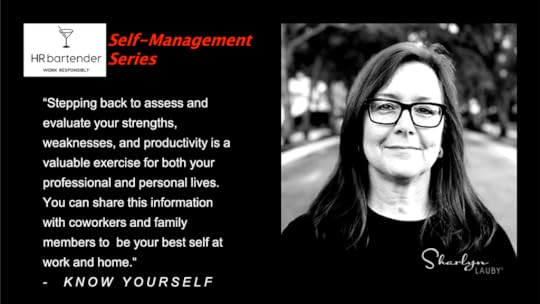
I’ve written in the past about the concept of self management. It’s defined as understanding and taking responsibility for our own behavior and well-being. Organizations want employees to be self managing. Frankly, employees want it too. When employees can manage themselves, then managers can effectively and efficiently delegate. They can delegate new responsibilities that help employees learn and grow in their careers. This allows employees to get promotions, accept new assignments, as well as everything that goes along with it (i.e. better compensation, etc.)
While he doesn’t refer to it as self management, Dan Pink talks about the concept in his book, “Drive: The Surprising Truth About What Motivates Us”. He says that there are three essential elements of motivation: autonomy, mastery, and purpose. Organizations and individuals have purpose. Employees often work for organizations because their purpose aligns with the organization’s. Organizations and individuals work together to master skills, which is the work that gets done every day.
It’s the third essential element that I believe is the most challenging – autonomy. This is what I refer to as self management. Employees need to have the autonomy to get things done. And it won’t happen by simply telling an employee that they’re autonomous.
The reason I’m resurrecting this conversation about self management is because of what’s happening right now in the workplace. Organizations still have a lot of employees who are working remotely. Those employees are aligned with the organization’s purpose. And they have skills mastery. The question becomes are they self managing (i.e. autonomous)?
So, I thought it might be interesting to start a discussion on qualities of self management in the context of remote work. The first quality to successful self management is knowing yourself. There are two aspects of knowing yourself that individuals should consider.
Understanding your strengths and weaknesses. I’d like to think that everyone has some sense of their strengths and weaknesses. We’re not just talking about technical skills. You should also consider those power skills – sometimes referred to as soft skills.
If you don’t know your strengths and weaknesses or you’d like some confirmation, pick up a copy of Marcus Buckingham’s “Now Discover Your Strengths.” In the book, there is an opportunity to take an assessment that can help you define your personal strengths. It’s a great way to begin your path of self-discovery. You can also review any profiles or assessments you’ve taken in the past.
Understanding your most productive and least productive selves. While this is related to your strengths and weaknesses, it’s not the exact same thing. Individuals should know the conditions that create their most productive selves and their least productive selves. Ask yourself these two questions:Think about a time when you were your most productive. When you were getting lots of things accomplished and the quality of your work was fantastic. What was going on around you in terms of your work environment, your boss and coworkers, and your physical surroundings? You might want to include your personal life as well. Once you’ve finished question above, the second question is to do the same but when you were your least productive.
It’s possible that over the past few months, you’ve identified some strengths and weaknesses you didn’t know you had. It’s also possible that you have a clearer sense of what it takes for you to be productive. Those are two steps important toward working autonomously.
Stepping back to assess and evaluate our strengths, weaknesses, and productivity is a valuable exercise for both our professional and personal lives. It allows us to keep focused and positioned to adapt as necessary. We can share this information with coworkers and family members so we can be our best selves at work and at home. And during those times when life is unexpected or challenging, we can draw from this information to manage ourselves well.
Speaking of work and careers, in the next article in this series, we’ll talk about how self management and our careers are intertwined.
The post Know Yourself – Part 1 of Self Management Series appeared first on hr bartender.






October 18, 2020
The Case for Aligning Diversity Initiatives with Incentive Compensation
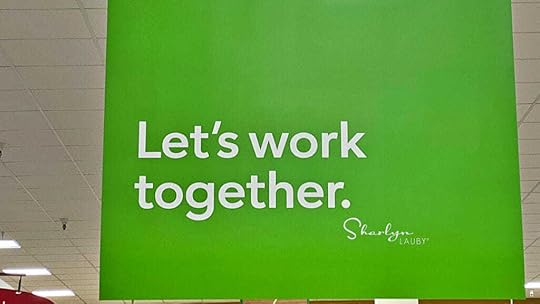
Remember a few months ago when organizations denounced systemic racism and said they were going to put initiatives in place to make their workplaces anti-racist and more equitable? Yep, I do too. The question becomes, “How are they doing?” It’s time for organizations to move past their words and move toward action.
That being said, I can see how this is going to be hard. It doesn’t mean that organizations don’t want to do it. But it will be hard. In many organizations, the way to create real change is to align goals with compensation.Gregg Passin, senior partner at Mercer, says that companies who want to “pay more than lip-service to their diversity, equity, and inclusion (DEI) goals are considering linking them to incentive plans.” So, I asked Gregg if he would share some details and thankfully, he said “yes”.
Gregg, thanks for being here. My apologies but I’m going to start out with a cynical question. Why should organizations consider linking DEI practices and incentive compensation? Shouldn’t organizations pursue DEI initiatives simply because it’s the right thing to do?

[Passin] It certainly is the right thing to do, and all organizations should assure the representation of their workforce reflects the communities they serve and are located, assure equitable treatment in pay, promotion, and other opportunities, and foster a sense of inclusion for all.
Some organizations will be able to do that without including it in their incentive plans, and some have already. Others will do so for optics reasons – to show all of its stakeholders that this is a critical mission that will affect pay, including on the downside for not achieving goals. And, some organizations that are very process-oriented should do so because that’s how they operate: everything that needs to get done go into incentive plans.
I believe that representation and inclusion are better metric choices because success in both requires programmatic commitment, strategy, and effective execution. Equity should be a requirement. For example, achieving pay equity needs to be expected; no one should get an incentive for achieving that. The reward for that is keeping your job.
If an organization is considering this (linking DEI and incentive compensation), should it only be at an executive level? Why or why not?
[Passin] Most actual DEI progress is made within the organization below the executive level. Ideally, anyone who can affect DEI change should be measured at some level.
But, some organizations prefer to start at the executive level because it is easier to introduce something new to fewer participants and, again, for optics. Some organizations also know that if the executives are being measured on DEI progress (or any metric) that others in their organizations will soon be aligned to it as well.
What are the 2-3 most common metrics that organizations can use to track DEI?
[Passin] Most use increased representation based on race and/or agenda: percentage of the workforce or percentage of leadership positions. Some will express that as growth and some as a desired state over time. Other metrics include inclusion of under-represented groups in all candidate slates and increased engagement with a more diverse supply chain network.
Increasingly, companies are looking at inclusion, measured by employee engagement scores or other forms of employee sensing.
For organizations considering the inclusion of DEI in incentive compensation, how can HR help create buy-in?
[Passin] To be successful, DEI needs to be seen as a business priority and not an HR initiative. Senior leaders, starting with the CEO and the CEO’s direct reports as well as the Board of Directors, need to fully support and embrace the organization’s DEI strategy and programs. HR can facilitate that buy-in and also help create the culture change needed to be successful.

Final question. This is a question about incentive programs in general. Sometimes incentive plans can be simply a “numbers game”. How can organizations ensure that, when they’re designing (or revising) an incentive compensation program, it truly achieves the desired positive result?
[Passin] Any metric needs to be tied to the most critical outcomes for the organization. Of course the compensation program can’t support every single thing that needs to be done. There need to be other programs (performance management, succession planning, etc.) that capture some of these outcomes as well.
Metrics need to balance the interests and expectations of participants, shareholders, and the company, and goals set to incent movement in the right direction.
I want to extend a huge thanks to Gregg for sharing his experience with this matter. Be sure to check out the Mercer blog for more insights on health, wealth, and careers.
I agree with Gregg that this approach might not be everyone, but it does open the organization up to discuss accountability. Organizations cannot make promises to employees, customers, and their communities without being able to explain how they will self-monitor and account for their words.
Image captured by Sharlyn Lauby while exploring the streets of Gainesville, FL
The post The Case for Aligning Diversity Initiatives with Incentive Compensation appeared first on hr bartender.






October 15, 2020
4 Change Management Strategies for Managing HR Digital Transformation

There’s lots of talk about digital transformation but do we really know what it means? And everything that’s involved? One of the best definitions I’ve heard was at last year’s KronosWorks conference. John Frehse, senior managing director at Ankura Consulting Group LLC, described digital transformation with the line, “Data is out. Answers are in.” His point was that digital transformation is about organizations getting answers through the strategic use of technology.
While technology is a key ingredient in digital transformation, it’s important to note that digital transformation isn’t about technology. Let me say that again – it’s not technology! It’s about organizational change. Here are a few Workforce Institute articles that share how to use change management strategies for managing HR’s digital transformation.
How to Use Data to Make Actionable Decisions
Digital transformation is about organizations getting answers through the strategic use of technology. But once organizations get answers, they have to do something with the information. I’ve always said that one of the worst things that organizations can do is ask employees for their opinions and then do nothing with it. The same philosophy applies. It doesn’t make any sense to collect a bunch of data and then do nothing with it.
The key is making data actionable. The question becomes how to do that. I wish I could say it’s easy but it’s not. Organizations need to take steps to make sure that they put their data to good use.
4 Steps to a Culture of Change
Change has probably never been a bigger part of our lives. Individually, we’re dealing with both personal and professional change every day. Part of that change could be working remotely. Organizations are facing change too. They have to decide if and when to bring employees back into the workplace. It’s possible that they will have to review and revise policies and procedures to keep employees safe and well. Maybe even make some very tough decisions about employee headcounts and operational expenses.
Organizations that try to micromanage a change effort are going to get really tired, very fast. And there’s no guarantee that the change effort will be successful anyway. Real results happen when employees are given the freedom to help the organization make change work.
A 5-Step Framework for Managing Organizational Change
As much as organizations and individuals want to return to “normal”, there are probably going to be aspects of business that change for a very long time, if not forever. That might not be terrible. There are some good outcomes emerging from this unprecedented time. But we’ve all seen the statistics that more than 70% of change efforts fail. Part of the reason is because organizations don’t do a good job of managing the change process.
The ADKAR Model can be used as a framework to achieve individual and organizational change. Models like ADKAR can help individuals manage professional change. They can guide managers and project leaders through new ways of doing business. And they can help organizations grow through processes like digital transformation. Giving all employees a roadmap for change and teaching them how to use it will benefit the individual and the organization.
Decades ago, the way businesses used to get answers was by sifting through piles of data. But let’s face it, employees really don’t like crunching the numbers. And just about the time they finish pulling all the numbers together, the data isn’t current anymore. Organizations are faced with a situation where they’re always being reactionary because they simply can’t keep up with the data.
Digital transformation is focused on creating a new way of business. It’s about giving employees answers and empowering them to make good decisions. Technology is able to crunch the numbers, do it quickly, and free up organizations, giving them the time they need to make business decisions. But organizations have to put a solid change management process in place to make the transformation successful.
Image captured by Sharlyn Lauby while exploring the streets of Cincinnati, OH
The post 4 Change Management Strategies for Managing HR Digital Transformation appeared first on hr bartender.






October 13, 2020
5 Components for Successful Organizational Analytics
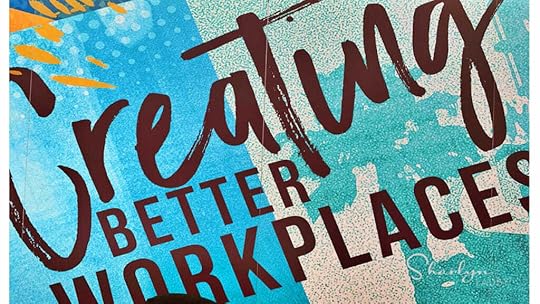
Earlier this year, I had the opportunity to attend the Society for Human Resource Management (SHRM) People Analytics Conference. During one of the sessions, speaker Jack Phillips shared five components for successful organizational analytics, and I wanted to share those with you.
I really liked this model because I felt like it was something the entire organization could support. I also thought that the acronym for the model – DELTA – was particularly catchy. Some people like using the world delta as a synonym for change. So, think of the DELTA model as a guide for transforming the organization to an analytics culture. Here are the five components:
DATA: This is the obvious one. If you want to have any type of analytics program or culture, then you need data. The organization will want to assess its access to both internal and external data. They will also want to commit to things like data quality and data security. It’s a perfect time to remember the technology phrase “garbage in, garbage out”. Good data helps organizations make good decisions and a commitment to quality data is essential.
ENTERPRISE: I think of the enterprise component from two angles. First that the organization has the right enterprise technology in place to retrieve internal data. And second that their technology systems “speak” to each other, meaning that there’s an ability to look at the relationships. This doesn’t mean that organizations need to replace all of their systems, but it does mean they need to look at the capabilities of their systems. It’s possible that some areas will need to be addressed.
LEADERSHIP: It almost goes without saying that leadership needs to be on board with using analytics in their decision making. I don’t want to take anything away from “gut feelings” and “vibes” but let’s face it, they can be wrong. We need to remember that it’s not only that leadership is on board with using data and analytics, but that they’re willing to dedicate resources toward analytics projects. And by resources, I mean headcount and budget dollars.
TARGETS: Think of targets as goals or areas of the business that could stand some improvement. The idea is that organizations identify targets to begin analytics projects. I’ve always said that one of the worst things that organizations can do is ask for employee feedback and do nothing with it. Same applies here. There’s no reason to identify a target for an analytics project if the organization isn’t willing to react to the data.
ANALYSTS: This ties into the second and third points about enterprise and leadership. Not only does the organization need to have the technology infrastructure in place but they need to have individuals who are capable of interpreting the data and following the rigor to make good decisions. In some cases, organizations may want to hire data scientists. And organizations can also invest in developing employees to take on these roles as the organization expands their analytics capabilities.
Now more than ever, organizations will be looking for ways to improve performance and do it quickly. I’m not suggesting they will do it at the expense of employees. That’s exactly why using data and analytics can be a valuable piece of their economic recovery.
It takes time to develop an analytics culture. This is something that organizations want to think about now, so it becomes a part of their short- and long-term strategic plans. Looks for ways to benefit from this shift right now and in the future.
The post 5 Components for Successful Organizational Analytics appeared first on hr bartender.






October 11, 2020
Yes, People Are Checking Out Your Video Background
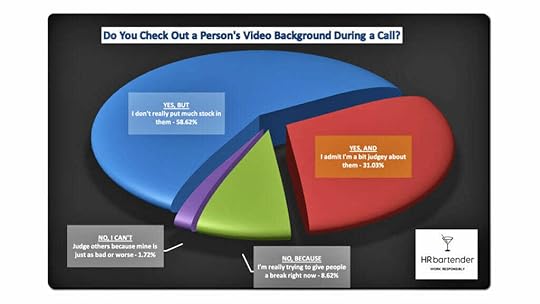
A couple of weeks ago, I asked you a question about “checking out a person’s video background during a call” and you can see how you responded above.
Honestly, this is not a surprise to me. And it shouldn’t be to you either. What’s in the background during your video calls says something about you. The question is does it reflect what you want it to say about you?
A friend told me recently that they view the background of video calls like going into someone’s office (pre-pandemic). It’s an opportunity to scan the room and maybe start a conversation about something. That’s good logic when you’re planning to be on a video call. Think about your background as your “office”. Is there anything in the background that you wouldn’t have in your office? Here are a couple of other things to consider when you’re on a video call.
Ask about the video option before the meeting. I think it’s time for meeting organizers to let people know when they schedule remote meetings whether or not the camera is strongly suggested or mandatory. “Zoom fatigue” is a real thing. If individuals don’t need to be on camera, let them know. Or ask that everyone be on camera to say hellos/goodbyes and the rest of the time, they can be camera off.
Try to avoid a patterned shirt. If you are asked to be on camera, think about what you’re going to wear. Sometimes video cameras make patterned clothing look too busy. It’s not you. The shirt is fine. It’s just what video cameras do with patterns. Solid colors are best. If you anticipate working from home for a few more months, it might make some sense to have a couple of video friendly shirts in your closet.
Look for a place with lots of light. This can be sunlight or indoor lighting. You look better in a well-lit room. If you expect to be on camera a lot over the next few months, you might consider getting one of those “ring” lights. They’re pretty inexpensive on Amazon. I was surprised at how it can filter out the glare, especially with my eyeglasses.
Test the equipment beforehand. Even if you’ve used Zoom, Skype, or Microsoft Teams a zillion times, it makes sense to check the equipment before the call. These applications are always making updates and what worked yesterday might not work today. This gives you time to fix anything prior. Also, for me, I do not leave my privacy settings on all the time for these apps, so it allows me to check that as well.
Tell people at the beginning if you need to go off camera. If the meeting expects you to be on camera, let participants know if there’s some reason you might need to turn the camera off. Maybe you’ll be eating. Or if this is a regularly scheduled meeting, have some common rules. When a kid comes in the room, it’s okay to turn the camera off.
We’re spending more time these days using our video cameras. It’s time to get comfortable with using them. That includes privacy settings, backgrounds, and what we’re going to wear. Because the better we are at participating virtually, then the more time we can spend on the meeting content.
The post Yes, People Are Checking Out Your Video Background appeared first on hr bartender.






October 8, 2020
5 Ways to Deal With an Annoying Colleague

Working with people you don’t like is a fact of life. Even when we’re working remotely, it’s possible that a colleague can still grate on our very last nerve. So what can we do about it? Well, before talking about possible solutions, let’s point out some realities about working relationships.
Everyone has at least one annoying habit. I have them. You have them. We all have them. This isn’t about one person’s annoying habit. It’s about maintaining positive working relationships.
Bringing up one person’s annoying habits opens the door for a discussion about everyone’s annoying habits. You have to be prepared to address everyone’s annoying behaviors, including your own. Take a moment to process that thought. It would not go well to tell one colleague, “Stop making clacky noises with your fake nails.” and not talk to the person who burns popcorn in the microwave and smells up the whole office. Or the person who hits “reply all” for every single email message.
If you don’t address all the annoyances, you will look like you’re playing favorites. Talking to one colleague and not another, could come across as targeting one person. It could hurt working relationships. This is especially true if the person doing the “pointing out” is a member of management.
That being said, this certainly doesn’t mean that annoyances shouldn’t be addressed. But before taking action, here are five questions to consider:
Does the annoyance stop people from doing their work? Obviously, if productivity is suffering, then something must be done. At that point, the focus should be on the loss of productivity rather than the annoyance.
Who is the best person to address this matter? Depending on the individuals involved, it could make sense to consult human resources or an office manager about the situation. And if this is an annoyance that’s widely known but hasn’t been addressed, it would be interesting to know why. Is there a legitmate reason or is this a case of tacit approval?
Is this a one-person issue or something that should be addressed on a team level? I mentioned earlier about pointing out other people’s annoying habits. Does this situation only involve a single person? For example, I’ve seen annoyances like not cleaning the breakroom or “reply all” apply to more than one person.
Is this matter worth potentially straining working relationships? Given that we all do annoying things from time to time, is this really worth mentioning? Or should employees learn to be more tolerant? This is one for each individual to decide.
Are there options that don’t involve confronting the person? If the annoying behavior has to do with working in an open office, is it possible that providing employees with headphones would help. That might solve a whole list of problems.
I wish there was a one-size fits all solution for all the annoyances we encounter. Because they happen all the time. The most important thing to do when these situations happen is think about the possible outcomes. We all need some self-awareness and maybe this person doesn’t realize what they’re doing. On the other side, maybe their habits are trivial compared to someone else’s annoying habit. Bottom-line: each of us must own our quirky behaviors.
P.S. One other thing that can help when these situations arise is making sure HR professionals know how to mediate conflict. If you’re looking to learn more about conflict mediation, I’m facilitating a virtual seminar for the Society for Human Resource Management (SHRM) starting November 2, 2020. Program details can be found on the SHRM website. I’d love to see you there!
The post 5 Ways to Deal With an Annoying Colleague appeared first on hr bartender.






October 6, 2020
HR Compliance: Minimize Administration to Maximize Productivity
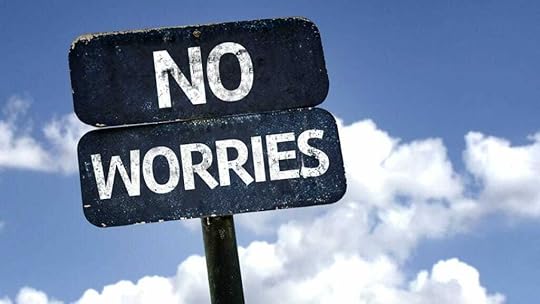
(Editor’s Note: Today’s article is brought to you by our friends at Poster Guard® Compliance Protection, a division of HRdirect and the leading labor law poster service that gets your business up to date with all required federal, state and local labor law postings, and then keeps it that way — for an entire year. Enjoy the article!)
I don’t have to tell you that HR departments are busy right now. They’re managing the return of employees to the workplace and drafting guidelines for employees who will continue to work remotely. In addition, HR is trying to figure out how to conduct virtual annual benefits enrollments, what the 2021 budget is going to look like, and should the company have any sort of holiday celebration.
All of these activities are important. Another functional area of human resources that’s equally important is HR compliance.
Compliance matters cannot be ignored. And many HR departments don’t have the time to do all the necessary research about each federal, state, and local law on their own. Or even if they can squeak out the time, is that really what brings the most value to the organization?
It’s probably not a surprise to hear that employers are responsible for informing employees about their employment rights. One of the most common ways employers do that is with labor law posters and handouts. But what might be surprising are the foreign language requirements.
In the 2018 Census survey, it was reported that there are almost 60 million Hispanic people living in the U.S., which is about 20% of the population. The survey also reported that approximately 41 million people, or about 14% of the population, speak Spanish at home.
That’s why in 19 states and Washington DC, it’s a requirement to post certain labor law notices in Spanish. Even if the organization doesn’t have any Spanish speaking employees.

In addition, there are some posters on the federal, state, and local levels that must be posted in Spanish or other foreign languages if you have a certain number of employees who speak that language. For example, the federal Family and Medical Leave Act (FMLA) poster must be posted in Spanish at locations with a “significant number” of Spanish speaking employees who are not proficient in English.

The law is a bit unclear on how to define “significant number”, so I asked Ashley Kaplan, Esquire, senior employment law attorney for ComplyRight for a suggestion. Ashley leads the legal team for Poster Guard. “FMLA regulations do not define ‘significant number’ but, based on similar state and local laws, it is a best practice to post in Spanish if 5% or more of the workforce is impacted.”
Complying with Spanish posting requirements is just one example of how complex and time-consuming labor law posting compliance can be. The good news is that there are services available to take care of the compliance for you. If you’re not familiar with the Poster Guard Compliance Protection Service, here’s a high-level overview of what the service offers.
It provides organizations with their required postings on a federal, state, and local level. In English, Spanish, and any other required language. As well as industry-specific postings. Notices can be provided in poster format, smaller binder format, and electronically to accommodate your hybrid workforce. Poster Guard will monitor federal, state, and local laws and send replacement postings when the posting requirements change.
I’ve used a labor law posting service in the past and cannot say enough good things about it. Think about what a service like this can do for HR department productivity.
Reduce administration time. HR departments should be spending their time on activities that require face-to-face interactions like recruiting, training, and performance coaching.
Ensure organizational compliance. Don’t get me wrong. Compliance is important. But we don’t have to do it alone. Services like Poster Guard can be a valuable member of our human resources team.
Do the right thing for employees. As I mentioned at the beginning of this article, employers have an obligation to tell employees their rights. Not only does the organization do the right thing in terms of compliance, but they do the right thing by directing their efforts toward other activities like training, performance, and recognition.
Now is the perfect time to make sure the organization has their labor law postings in order. So, HR can focus on helping the organization get back to the new normal.
If you want to learn more about the Poster Guard Compliance Protection Service, check out their website. HR Bartender readers receive a special discount for $30 off Poster Guard Compliance Protection including FREE ground delivery right now using the code SC32767. Don’t miss out!
The post HR Compliance: Minimize Administration to Maximize Productivity appeared first on hr bartender.






October 4, 2020
4 Steps to Create a Support Driven Company Culture
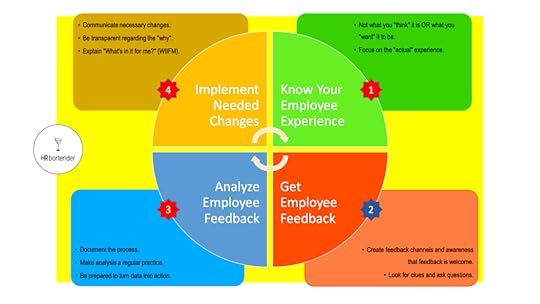
Several months ago, I shared an article about using empathy maps to design a better employee engagement experience. The article was from a WordCamp Miami session Mr. Bartender and I attended earlier this year.
Another session we attended during the conference was about creating a “support driven” business. While the session was really aimed at being a customer support driven business, I could easily see how the model they shared could be applied to creating a support driven company culture. Above is the model I sketched during the session for creating a support driven business so you can see for yourself.
One of the things that I love about this model is the emphasis it places on feedback. Over the past few years, organizations have dedicated a lot of resources toward improving feedback mechanisms – at every level of the organization. While I think that the initial focus of those resources has been to replace the traditional performance review model, that doesn’t mean it can’t be used for something like this. Feedback is a good thing. Why not use it to develop a support driven company culture?
In fact, this type of model can support the organizations efforts with regard to performance management because, in this model, no feedback is a bad sign. Performance management systems work because they have good processes, feedback channels, and outcomes.
Creating a support driven company culture relies on employee feedback just like creating a support driven business relies on customer feedback. We’ve become a society that appreciates recommendations and feedback. As consumers, we get it via reviews on Amazon and status updates from our Facebook friends. On the work side, we rely on others to tell us about the candidate and employee experiences on Glassdoor and Indeed. And we use that information to make decisions about whether to apply or take the job offer.
I can see creating a support driven company culture improving employee engagement (because employees feel comfortable sharing feedback), reducing turnover (because employees see the company taking action on their feedback), and improving performance (because employees feel invested in the company’s success).
Human resources departments can use this model to maintain relevancy in a constantly changing business landscape. Our role becomes being the advocate for feedback from employees, managers, and executives. We help the business analyze the data to create a winning solution for everyone. And we support the change management process, so the organization becomes stronger with every iteration.
The post 4 Steps to Create a Support Driven Company Culture appeared first on hr bartender.






October 1, 2020
How Organizations Can Build a More Diverse Workforce – Ask #HR Bartender
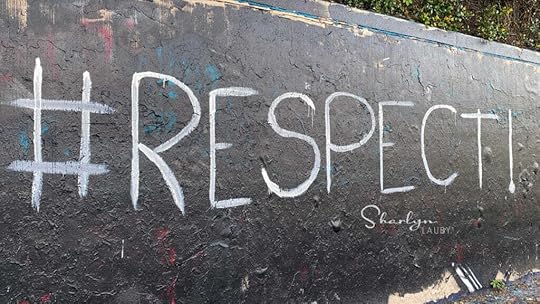
I don’t have a specific reader note today but I do want to address a question that readers have been asking frequently. “How can my organization recruit a more diverse workforce?” It’s a good question and one that deserves our attention.
To help us answer the question, I reached out to Jackye Clayton. She is a consultant focused on diversity, equity, inclusion, and belonging solutions. And she’s been named one of the “50 Unstoppable Women in HR Tech”. In fact, that’s where I came to learn of her work…at the HR Technology Conference & Expo.
Jackye, thanks for being here. Before we talk about organizations, I’d like to get a little personal. What does diversity and inclusion (D&I) mean to you?

[Clayton] To me, diversity at work means creating a group of unique individuals – a variety of races ethnicities, genders, sexual orientations, socio-economic history (which ideally is evened out through salary normalization), ages, physical abilities, religious beliefs, political beliefs, or other ideologies.
Inclusion means that all of those unique individuals have a voice and are considered in the future of the organization for which they work.
What’s the first thing that organizations need to do if they want to attract a more diverse workforce?
[Clayton] The first thing they need to do is analyze the environment to understand corporate history and existing workplace culture with the goal of finding out how they got there. Survey all current employees and ask them to anonymously discuss how they perceive the diversity in their workplace. Also gather the data that only the organization knows such as salary, promotion, and turnover history to get a better view as to the opportunities for diverse groups.
I recently published an article on the SHRM website about talent management trends . Recruiting Animal contributed to the piece saying that organizations are asking HR departments to find more diverse candidates. How can HR build a more diverse candidate pipeline?
[Clayton] HR can build a more diverse candidate pipeline first by diversifying where they are looking for candidates. Also, be transparent in your recruiting marketing. Let people know that you are wanting to expand your reach by attracting a diverse group of people and experiences.
I believe it’s not enough for organizations to say they value D&I. They also need to show it. Name 2-3 things that organizations should incorporate into their candidate experience to demonstrate they value diversity and inclusion.
[Clayton] To show that organizations value D&I, here are three things they should consider:
Make diversity a policy rather than a program. A program is more of a short-term response to a problem that organizations are trying to solve. Hiring and retaining a diverse group of employees is an ongoing area of opportunity and therefore needs to be baked into a company policy. It informs others of your company’s expected values, mores, and ethics.
Share the plan behind the policy. Share the roadmap. Tell everyone who will listen where are you are going and how you will get there!
Share the numbers. While diversity hiring usually falls under HR, it is truly is a company wide effort. Because of this, you should regularly report on the efforts you are taking to create a more diverse workforce and what has been the impact of those efforts. Be honest if you have made mistakes along the way and show how you are remedying those mistakes. And share those numbers both internally and externally so that potential candidates can feel confident that the organization values diversity and see where the organization is headed and prevents hesitation to apply in fear of tokenism.
Final question. You mentioned that organizations should “share the numbers”. How can organizations measure their success when it comes to diversity recruitment efforts?
[Clayton] Create hire to retire measurement plans. It is not enough to simply look at how many diverse members are being hired. Start with looking at how many diverse candidates you are attracting organically. Next look at where you are losing candidates along the way before the hire is made.
Once diverse candidates are added to the team, you must measure their employee experience. Make sure you are measuring internal opportunities for growth in the way of training and education as well as opportunities for promotion. From there you need to measure turnover to see if you are losing diverse candidates in particular business units. Hold leadership accountable for creating a place where all are welcomed and given equal opportunity.
I want to extend a HUGE thanks to Jackye for sharing her experience and expertise with us. Be sure to connect with her on Twitter at @JackyeClayton to learn more of her insights.
Many organizations have recently pledged their commitment to building a diverse workforce. It’s time to do more than simply say diversity is important. Organizations need to show it.
Image captured by Sharlyn Lauby at the 34th Street Graffiti Wall in Gainesville, FL
The post How Organizations Can Build a More Diverse Workforce – Ask #HR Bartender appeared first on hr bartender.






Sharlyn J. Lauby's Blog
- Sharlyn J. Lauby's profile
- 10 followers






